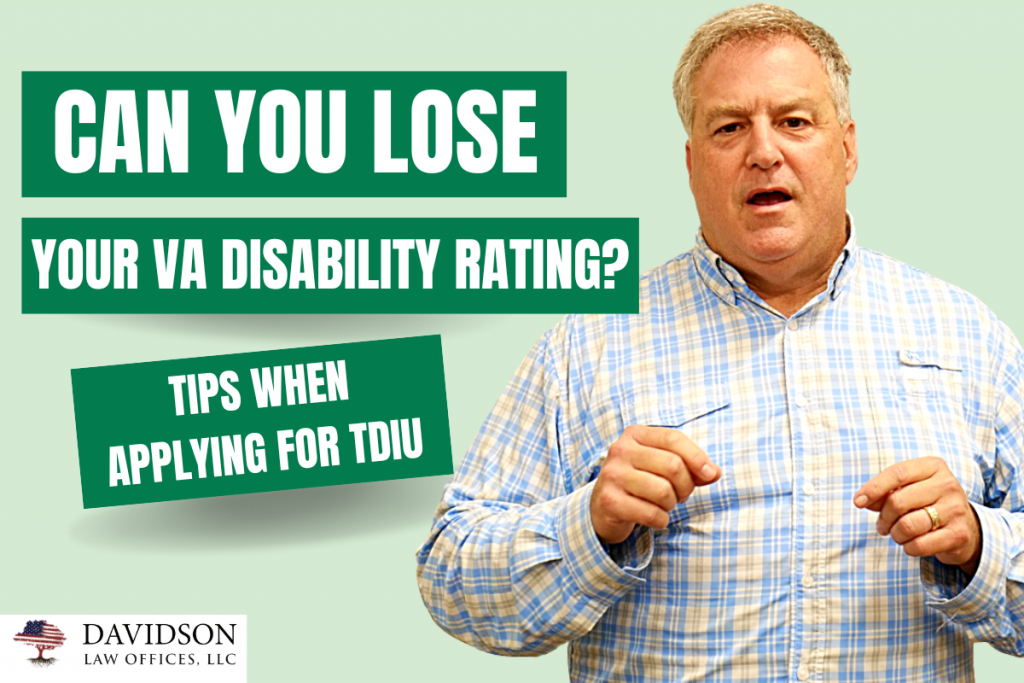Several months ago we published a YouTube video about Total Disability Individual Unemployment (TDIU) for Veterans and we’ve received a lot of good feedback on that video. One of the more frequent questions was whether a Veteran could lose their current disability rating when making a claim for TDIU. That’s a scary proposition for many folks. You don’t have a 100% rating, but see TDIU as a way to get that 100% rating. Are you going to risk your current rating by trying to get TDIU? That’s what we’ll be talking about here.
TDIU is based around the idea of individual unemployability. If you can’t be gainfully employed because of your service-connected disability or condition, you may be eligible for an increase in your scheduled rating. The focus of TDIU is on your ability to work. It’s not that you don’t want to work. We know that you don’t want to be “laid up” at home and that you want to be a productive member of society. But what is your ability to work?
A 100% disability rating via TDIU is an individualized rating. That rating is specific to you and no one else. It’s not based on the average Joe (or Susan). It’s based upon your ability to work given your service connected disability. The VA defines substantially gainful employment as an occupation where non-disabled individuals earn a livelihood comparable to the particular occupation in the community where the Veteran resides. In simpler terms, what is a living wage where you live?
Marginal employment is not considered substantially gainful employment. If you were a pilot but can no longer perform that job because of back duties, you don’t have to be a baggage handler now. The VA looks at your occupation prior to your service-connected injury. That’s what they’ll use to determine if you’re eligible for a rating increase via TDIU.
The Courts have also interpreted the meaning of substantially gainful employment. They define it as an occupation providing you with annual income that exceeds the poverty level for one individual. The number of hours you work in a given week doesn’t matter. This definition is focused on whether the occupation provides you with annual income above the poverty level.
This definition has both an economic and non-economic component. The economic component states that the occupation must allow you to earn more than the marginal income as determined by the government. The non-economic component involves your ability to secure or keep a specific occupation. Does your service-connected disability prevent you from doing the job or occupation that you were trained to do prior to your injury?
If you were a pilot in the military but now have a bad back, you certainly couldn’t be a baggage handler. You also probably can’t stand for a long period of time, so working at the check-in line isn’t an option either. The VA looks at your physical ability, both exertion and sedentary. They’ll also look at your mental ability to perform activities required by a certain job. If you have PTSD and crowds bother you, you probably can’t work in a factory with a lot of loud noises.
The VA can’t allude to your educational and occupational history without attempting to relate these factors to your disability. They can’t look at your inability to stand or lift heavy objects and force you to work a job putting caps on toothpaste all day. That’s not right. They have to look at your ability to perform the types of activities that your prior training allowed you to do.
Your Evidence for TDIU
When apply for TDIU, the ultimate question is does your evidence support your claim. Are you able to acquire and maintain substantial gainful employment as a result of your service-connected disability? Or to put it in a different way, do your service-connected disabilities prevent you from securing and keeping a substantially-gainful occupation? It will depend on your disability in a given occupational environment. Your evidence has to be individualized to your specific situation and not to the average person.
Some Veterans will utilize vocational experts to provide them with vocational assessments. If that works and is favorable for you, by all means let’s use it. The VA is going to look at whatever evidence you submit. But their object is to not give it to you. They’ve already given you a scheduled disability rating and they didn’t feel you needed to be 100%.
Back to the original question — should you be scared to file a TDIU claim for fear of losing your current disability rating? The VA may require you to be re-examined by a VA physician or undergo a period of hospitalization or observation. They must verify the continued existence or the current severity of the service-connected disability.
Remember that based on timing, after a number of years they can’t come back and re-examine you. But if you’re new to the service connected disability rating system, they can come back and re-examine you. If they think the evidence indicates that there has been a material change in your disability since your last examination, they can order a re-examination. They can also require you to be examined to comply with their statutory duty to help you in the development of your TDIU claim.
We suggest that you carefully gather any and all evidence prior to filing a TDIU claim. Go see your doctors and/or a vocational expert and get some documented evidence that you cannot be substantially gainfully employed. Whether it’s because of your knees, hips, back, etc., you need professional evidence to support your claim. You must prove that you are 100% disabled due to your inability to be gainfully employed. If you don’t have the evidence, don’t submit the claim. But if you have the evidence, don’t be scared to file the TDIU claim.
Contact Us So We Can Help!
If you need assistance with a TDIU claim or are wondering whether you should submit a TDIU claim, you can complete this form or give us a call at (229) 226-8183. We’ll ensure that you don’t compromise your current disability rating by requesting a 100% rating through TDIU.
If you’d like to see this blog in video format, you can watch it below. Please be sure to SUBSCRIBE to our YouTube channel and click the bell notification button so that you’re notified each time we publish a new video.

